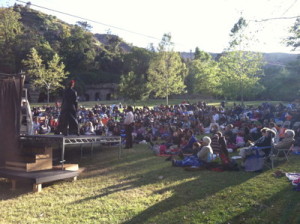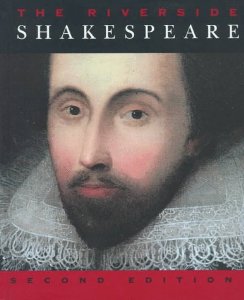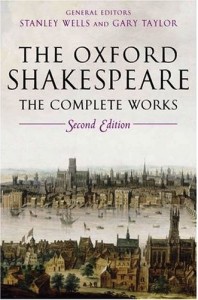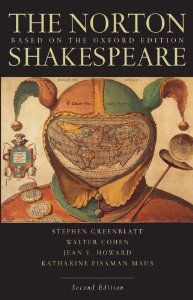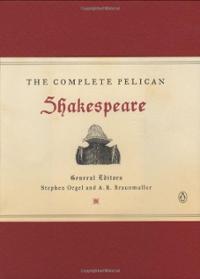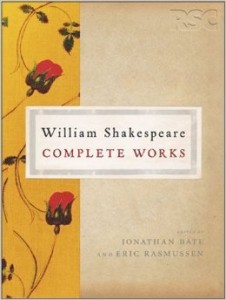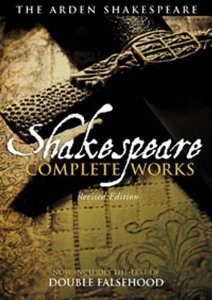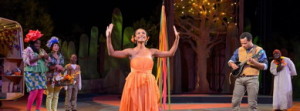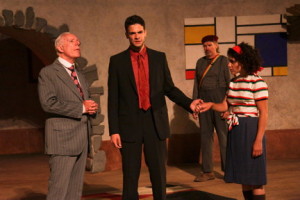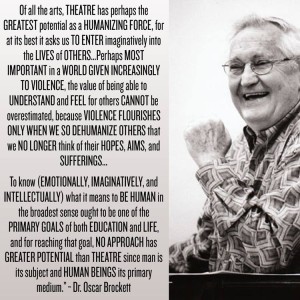The Spring/Summer Classical Theatre Season in the San Francisco area
March 5, 2014 § Leave a Comment
Summer always means lots of Shakespeare, but with the 450th birthday approaching in just a few weeks, the classical season is shaping up a bit early this year. Below are some of the highlights of the coming season. Shakespearean comedies are heavily represented, as would be expected in a celebratory year, but surprisingly no histories this year anywhere!
The productions about which I am personally most excited appear in bold.
March 1-16
The Taming of the Shrew
College of Marin Drama
835 College Ave
Kentfield
March 6-16
Measure for Measure
San Francisco State University
1600 Holloway
SF
March 7-16
The Tempest
City College of San Francisco
Diego Rivera Theatre
50 Phelan Avenue
SF
March 8-30
Medea by Euripides
African-American Shakespeare Company
Buriel Clay Theater
762 Fulton Street
SF
March 14 – April 13
Arms and the Man by Bernard Shaw
Ross Valley Players
30 Sir Francis Drake Blvd.
Ross
April 3-5
The Bacchae by Euripides
UC Berkeley Theater
Zellerbach Room 7
Berkeley
May 1-24
Romeo and Juliet
Ninjaz of Drama
Phoenix Theatre
SF
May 3-25
Much Ado About Nothing
African-American Shakespeare Company
Buriel Clay Theater
762 Fulton Street
SF
May 22 – June 22
Macbeth
We Players
Fort Point
SF
May 23 – June 15
As You Like It
Novato Theater Company
5420 Nave Dr.
Novato
June 13-29
The Taming of the Shrew
Othello (in rep)
Shady Shakespeare Theatre Company
Willow Street Park
San Jose
June 19 – July 6
Much Ado About Nothing
Livermore Shakespeare Festival
Concannon Vinyard
Livermore
June 25 – July 20
Comedy of Errors
CalShakes
Bruin Amphitheater
Orinda
June 28 – Sept. 21
The Taming of the Shrew
San Francisco Shakespeare Festival
Amador Valley Community Park (6/28-7/13)
Memorial Park (7/19-8/3)
Sequoia High School (8/9-24)
The Presidio (8/30-9/21)
July 1 – August 10
As You Like It
Santa Cruz Shakespeare
Stanley-Sinsheimer Festival Glen
Santa Cruz
July 9 – August 8
Twelfth Night
Shotgun Players
Ashby Stage
Berkeley
July 11 – August 10
As You Like It
Marin Shakespeare Company
Forest Meadows Amphitheatre
San Raphel
July 13 – August 10
The Merry Wives of Windsor
Santa Cruz Shakespeare
Stanley-Sinsheimer Festival Glen
Santa Cruz
July 17 – August 11
A Midsummer Night’s Dream
Vallejo Shakespeare in the Park
Hanna Park, Vallejo (7/27-28)
John Muir Amphitheatre, Martinez (8/3-4)
Peralta Hacienda Historic Park (8/10-11)
July 30 – August 24
Pygmalion by Bernard Shaw
CalShakes
Bruin Amphitheater
Orinda
August 15 – September 1
As You Like It
Shakespeare Napa Valley
Veterans Memorial Park
Napa
August 23 – Sept. 14
The Tempest
Curtain Theatre
Old Mill Park Amphitheatre
Mill Valley
August 23 – Sept. 27
An Ideal Husband by Oscar Wilde
Marin Shakespeare Company
Forest Meadows Amphitheatre
San Raphel
August 26 – Sept 28
Romeo and Juliet
Marin Shakespeare Company
Forest Meadows Amphitheatre
San Raphel
Sept. 3-28
A Midsummer Night’s Dream
CalShakes
Bruin Amphitheater
Orinda
My Annotated List of Shakespeare Editions – Complete Works
November 17, 2013 § 2 Comments
Annotated List of Complete Shakespeare Editions
Kurt Daw, November 2013
To many novices, the biggest shock about the plays of Shakespeare is discovering how different one edition can be from another. “Why don’t they just print what he wrote?” readers ask in despair. The very good reason is that no one is sure exactly what that was. There are NO definitive scripts. We have no manuscript versions, and the oldest printed editions contain obvious mistakes, problems and omissions. Where more than one Renaissance edition of a play exists (and some exist in two, three and even four substantive versions) different words, different speeches and sometimes completely different scenes exist. The variances can be so great in some cases, like the two substantially different versions of King Lear, that recent editors have treated them as separate plays.
Renowned editor and scholar Stephen Orgel has argued that plays in the early modern era were never absolutely fixed, but were considered collaborations between playwrights, theatre companies, and printers. Our modern idea of a definitive text did not exist. Stephen Greenblatt summarized this situation as unresolvable in his famous essay “The Dream of the Master Text.”
An Edition is a Version
All editions are versions, guided by different editorial aims about what they should accomplish.
With the advent of digital technologies, facsimiles (something like a photocopy) of the earliest print editions are easily and widely available online. These require some bibliographic expertise to interpret, however, because different spelling, typesetting, and printing conventions of the time make them shockingly difficult to read and use.
A page from the First Folio
Although purists argue that the plays are fundamentally changed by doing so, much of the difficulty of using facsimiles is alleviated with texts that use modern conventions for spelling, punctuation and printing. Even once those are in place, however, the issues are just beginning. If two people sit side-by-side with two different editions, there is no guarantee that the words will be the same, that the content of the scene will be identical or even that the characters in a scene will have the same name. ALL editors have to make judgments about which options to include and which to exclude from their edition. They have to decide what mistakes were made in the Renaissance printings and how best to repair them.
They also have to make educated guesses about what is important and useful to the users of their edition in order to understand and appreciate it. Because of that most editions also come with supplementary materials. These constitute notes about the meaning of words, phrases and references in the plays. They may (but do not always) include explanations about what textual variants were available and how the editor determined which ones to use. They may also include such things as biographic materials about Shakespeare, stage histories of the play, and essays about modern interpretations.
When you buy a Shakespeare play or complete works, because Shakespeare is not getting any royalties, what you are paying for is the editorial expertise. (The truth is that you mostly get what you pay for.) The range of choices can be bewildering. Below is my subjectively annotated list of the major editions of the Complete Works currently available, along with their strengths and weaknesses. (I will discuss major play series which publish titles in individual editions in a subsequent separate post.)
Globe edition (1864), an abridged version of the Cambridge edition (1863-6)
Dozens of different editions of Shakespeare’s plays exist, but the overwhelming odds are that the one(s) you already own are reprints of the 1864 Globe edition, edited by William G. Clark, and William A. Wright, with John Glover. If your edition does not clearly say who edited it, then it is almost certainly the Globe edition. There are a lot of reasons that this may be so: When it was published as a single-volume, popular version of the weighty Cambridge edition (stripped of its notes and apparatus), it was the best scholarship available. It remained the standard edition for over a century and almost all criticism was keyed to its line numbers. It was the first true academic edition backed by the reputation of a great university. But all of that pales in comparison to the simple reason it continues to dominate the market today: It is long out of copyright and its text can be reproduced inexpensively. In fact, with no printing costs attached, it is available all over the internet for free.
In truth, if all you want to do is give a play a quick read, it is probably good enough, which is why it still flourishes. Nonetheless, it has some weaknesses that make it problematic. The big one is that it has no notes or explanations. It is just a playscript. As many a student trying to save a few dollars has discovered, that renders it almost useless for an initial encounter with Shakespeare. It also makes almost all the editorial changes invisible. The editors were prone to extensive, but unexplained, emendation. They repaired word choices they found unclear, poetic rhythms they assumed were incorrect, and material they found indecorous, but in a way that completely escapes the average reader. For those who need a greater degree of transparency about editorial intervention, which includes all actors along with most serious students, this will not do.
The good news is, because of its electronic availability for free, there is no reason ever to purchase a copy. It is easily consulted online if you want to know what this edition says.
One of the innumerable forms in which the Globe edition is available.
The Riverside Shakespeare, 2nd Ed. (1997)
The Riverside is a large, single volume edition of the complete plays that became a favorite of English departments as soon as it was originally issued in 1973. A substantial reworking resulted in a second edition in the late ’90s. In editions of Complete Works, the supplemental materials are meant to apply to the entire canon, so they are informative about social context but not particularly tied to any specific play. The major of notes are definitional glosses on the text. Textual variants are recorded at the end of the play. There is not much commentary on the play, so the text largely stands on its own. Throughout the punctuation is considerably lightened from what you find in other editions.
Once the industry standard for a complete works, it is now largely superseded by newer editions below. (Because of that, however, you can sometimes find quite inexpensive used editions.)
University of Chicago professor David Bevington is something of a legend in the field of Shakespeare studies. He is the only modern editor to have single-handedly edited the entire canon for a major publisher. Surprisingly, it is much less ideocentric than comparable editions where multiple editors are involved. The supplementary materials are again meant to apply to the entire cannon, rather than being specific to any particular play, but are excellent. In a short, but very useful, essay Bevington discusses Shakespeare’s use of language in greater depth, and with greater insight, than any other editor. The latest edition’s greatest strength is another essay that sorts criticism from a vast range of perspectives into recognizable categories and approaches.
While in many ways quite conservative editorially, Bevington introduces some very helpful devices. Line numbers appear for all lines that have notes attached rather than every ten lines in other editions. The amount of time that saves counting up and down is alone enough to endear him to students! Bevington has practical theatrical experience but that does not color the notes attached to specific plays, which are more literary in nature. The dense introductory essays to the plays, however, discuss broad interpretive trends from a very theatrical perspective. (The edited text is also available in individual editions, which do have the notes and introduction but do not have the rich introductory materials of the Complete Works.)
The Oxford set off a revolution in Shakespeare editorial practice by prioritizing the “revisions” included in the Folio over the quartos as control texts. Previous practice had been to get as close to Shakespeare’s original manuscript as possible, generally emphasizing the earliest “reliable” quarto text. It has long been recognized that the Folio was heavily influenced by promptbooks from the theatre, so major changes introduced in it were thought of as theatrical corruptions to Shakespeare’s work. Wells and Taylor argued that Shakespeare was a working member of the acting company, however, and if the Folio records revisions made to the script, Shakespeare surely approved them. He probably actually wrote them.
Their new perspective resulted in a vastly different edition (or rather, two editions, since it is published in both modern and old spelling versions) than anything that had preceded it. The Oxford edition has as much commentary, and as many notes, as the Riverside or Bevington. Oddly, however, the publisher printed the complete works in a compact volume and then moved all the supporting materials to a companion volume. You have to buy two books if want access the scholarship, some of which is very theatrically oriented and might be really helpful to actors if it was better known.
(Caution: Individual plays are published separately as the Oxford Shakespeare, but these are separate versions with different editors.)
Oxford‘s mystifying decision to separate notes and commentary from text created an opening which Norton, the American publisher best known for collegiate anthologies, rapidly exploited. They licensed the Oxford‘s play texts and used them for the basis of their edition, which does come complete with extensive notes and commentary – but not the Oxford notes. Instead they brought in a new editorial team led by Stephen Greenblatt to supply entirely new supplementary materials. (They also made some minor adjustments to the most eccentric editorial decisions, especially the renaming of Falstaff, which they reversed.) The Norton is the most widely adopted of all current Complete Works editions. It has extensive textual glosses – and light contextual notes – available right next to the text. It restores some diacritical marks, mostly just for sounded past tense endings, which does give actors occasional scansion help. All notes, however, seem more theatrical than competitive editions.
Complete Pelican Shakespeare (2002)
Actors either love or hate this edition. It is a very compact version, made possible by a paucity of introductory materials, short pithy notes and a lot of small type. To many those are bugs, but some actors think they are features because (like the Oxford compact edition) it is light enough to carry into rehearsals. The layout is elegant and uncluttered. Glosses are relegated to the bottom of the page. The general editors are Stephen Orgel and A.R. Braunmuller. Co-editor Stephen Orgel is one of the most erudite scholars working today, but because of the concise format, little of that insight is captured in this edition. You have to read his essays published elsewhere to see and understand his skill.
The most recent of the complete editions is a version by Jonathan Bate and Eric Rasmussen for MacMillan UK and marketed as the Royal Shakespeare Company edition. Generally recognizing the revolution caused by the Oxford, but asserting Wells and Taylor did not go far enough, the RSC editors flatly state that what they have produced is an edited version of the Folio. Unlike all the previous work done to try to get to “the plays as they came from Shakespeare’s hand” or in Oxford’s case, “the plays as they were first performed” the RSC editors built their edition around a material, rather than platonic, book. Although that may lead in practice to many of the same choices as are contained in the Oxford, the logic is different getting there. The notes, therefore, are a reversion to a more bibliographic set of concerns. Interestingly, however, because of the association with the RSC, the introductory materials are much more theatrical. There is also some very interesting material in brief introductions to the plays including line counts, and percentage of the play those occupy, for the major characters and some other revealing statistics. In the US it is much more expensive that comparable editions, but it is a notable addition to the field.
The Arden Shakespeare Complete Works (2011)
By far, the most scholarly and admired Shakespeare series is the Arden, of which the single-title editions are indispensable for their superb introductions, notes, and glosses. Arden gathers their edited playtexts into a single large edition, but it is completely shorn of all the scholarship and contextual materials that make the series famous. It is the least useful of all Complete Works. (Although the date of the second edition is recent, the collected contents generally date from the ’80s and ’90s.)
Decision: I give a slight edge to the Norton, for its excellent supplementary materials and actor-friendly notes. A close second would be the Bevington, with supplementary materials that are superior to the Norton’s but more literarily oriented notes, which do not help the actor enough.
Disclaimer: Titles of editions, above, are linked to Amazon.com, to which I have an affiliation. This means if you decide to make a purchase from them, I will get a sales commission. But that doesn’t mean my opinion is for sale. Every affiliate link on my blog is to products that I’ve personally used and found useful. Of course, all these volumes are available from numerous other sources as well.
The Most Produced Playwright in America
November 12, 2013 § Leave a Comment
Every season, Theatre Communications Group (TCG) – the organization of America’s not-for-profit theatres – puts out a list of the 10 most produced plays by its nearly 500 members. (Because they recognize ties, it is often more like the Top 15…) Although it covers only a segment of the American Theatre scene, (because it does not include for-profit, academic, or amateur theatres) its annual list is a quick way to get the pulse of what plays and playwrights are currently hot. That is a very useful list for performers thinking about where to put their time and energy familiarizing themselves with scripts, with names to watch, and with sources for audition material.
Recently, TCG put out their list for the season now underway, topped by David Ives’ Venus in Fur which has an impressive 22 productions scheduled across the nation this year. The breadth of representation drops off rather quickly, however. Five titles tied for tenth place, a spot that just seven productions would earn.
For the last season for which complete records are available (2012-13), a mere 17 productions was enough to earn the top spot for David Lindsay-Abaire’s Good People, with Bruce Norris’ Clybourne Park a close second with 15 productions.
What is not immediately obvious, however, is that TCG makes two exclusions to their counts: They do not include holiday shows, like the ubiquitous Christmas Carol and the current small budget alternative, The Santaland Diaries, both of which would have shot to the top of the list.
More surprisingly, they do not list plays by Shakespeare. Yet every year Shakespeare plays would rank quite high on the list if they did. In the 2012 season, according to a title search using TCG’s data, 11 productions of Hamlet and A Midsummer Night’s Dream each would have placed them in a tie for sixth place with John Logan’s Red. With 10 productions, Romeo and Juliet would be in a tie for seventh place. 8 productions each of Measure for Measure, Twelfth Night, and Henry V would have placed all of these on the top ten list, with Much Ado About Nothing and The Tempest both finishing only one place out of the running.
Although it is not immediately apparent, Shakespeare had eight plays on the “top eleven” list last year, while no other playwright appears even twice. All told, according to a quick search of the TCG website, Shakespeare received a total of 127 productions last year. The year before, he received 153. The year before that 148.
My purpose is not to quarrel with TCG’s exclusions. They are open about their methodology, and their support of new American work.
When students ask me, however, about where to spend their time and energy, I am always quick to remind them the most produced playwright in America – who, by the way, has occupied this position for every single year of the last hundred years – is William Shakespeare.
Review: SUEÑO performed by the A.C.T. Master of Fine Arts Program
October 13, 2013 § Leave a Comment
During the early part of the 17th Century, while Shakespeare and his contemporaries were active in London, an equally vital theatrical period, the Siglo del Oro, filled the stages of Spain. Despite the sweep and power of the plays, they are criminally neglected in the contemporary repertoire. It is difficult to find an opportunity to see one.
If you are anywhere near the San Francisco area don’t miss the chance, therefore, to see the A.C.T. Master of Fine Arts program’s production of Sueño, translated and adapted by José Rivera from the great Pedro Calderón de la Barca’s La vida es sueño (Life is a Dream.) You will quickly see what all the fuss is about.
Calderón’s philosophical drama tells the story of a crown prince, Segismundo, secretly imprisoned in isolation from birth because of the prophecy that he would bring disaster to his country. When his remorseful father decides Segismundo should be given a single day to prove the prophecy wrong, he is drugged and brought to the palace. The twenty-five-year-old Segismundo awakes to find himself a king. He reacts with violent anger about the lifetime of deprivation and humiliation he has unjustly suffered, and he loses control. After injuring a palace servant and attempting to rape the first woman he has ever seen, he is again drugged and returned to his prison where he is told it was all a dream.
His people now realize his plight, however, and a rebel army storms his prison and releases him. Segismundo is unsure whether this is a dream or reality, but he resolves to act as if every fortunate occurrence in experience might be a dream gift from which he might awaken (and lose) at any moment. The rebellion secures his throne and he becomes a benevolent ruler – or maybe just has a very good dream…
Puerto Rican playwright José Rivera’s (The Motorcycle Diaries, Marisol) adaptation sharpens the plot slightly, and brings a contemporary wit and sensibility to the dialogue.
As befits a training exercise, the production values at A.C.T. are minimal and many of the actors are being pushed to the limits of their current abilities. What a great choice this is for actor training, however, as the Shakespearean scope brings out their best. The philosophic complexity which questions notions of privilege, and allegorically explores the possibility that God does not exist, makes them learn to structure rhetorical arguments in intellectually and emotionally communicative ways.
And that they do! In particular, Ryan Williams French is a moving Segismundo and Philip Estrera as the old counselor, Clotaldo, who teaches the prince humanism is outstanding. Dominique Salerno brings enormous joy and humor to her cross-gendered performance as the clownish old servant, Clarin.
This production is surprisingly concrete, lacking some of the dreamy vibe for which Rivera is especially known. (If you ever get the chance, catch his References to Salvador Dali Make Me Hot for the best example.) The trade-off is that Director Domenique Lozano focuses her production around the very timely question of what constitutes honor, and honorable behavior. Perhaps that is especially appropriate. As I write, we are entering week three of a most dishonorable shutdown of the Federal Government, which certainly feels less like a bad dream than a very solid reality. For anyone who loves classical drama, this is an opportunity that must not be missed.
Review: A WINTER’S TALE at CalShakes
October 10, 2013 § Leave a Comment
It is one thing to believe that the genius of Shakespeare’s plays lies in their universality, and quite another to put that belief into practice. CalShakes’ current offering of The Winter’s Tale has the courage to do the latter, and the results are stunning.
Patricia McGregor’s production is cast entirely with actors-of-color, and not in that allegedly “colorblind” way that whitewashes their experience, but in a manner that invites serious consideration of the stories that diverse communities tell about their particular histories. By particularizing the story, she paradoxically enlarges it.
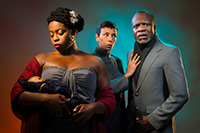
Omozé idehenre as Hermione, Margo Hall as Paulina, and L. Peter Callender as Leontes in Cal Shakes’ A Winter’s Tale by William Shakespeare, directed by Patricia McGregor; photo by Kevin Berne.
The Play
A Winter’s Tale is one of the last, perhaps the very last, complete play Shakespeare wrote. The plot is straightforward: King Leontes goes (literally) mad with jealousy, and publicly accuses his wife, Herminone, of adultery with his best friend – a visiting king, Polixenes, who barely escapes the country with his life. Leontes imprisons and then publicly tries the pregnant queen – whose only defender is a powerless waiting woman, Paulina. In prison, Hermione gives birth to a daughter, whom Leontes immediately sentences to death by being abandoned in the wilderness. Paulina reports that the combined strain of childbirth and the humiliation of the show trial has killed Hermione. Within minutes, the queen’s innocence is definitively established. The suddenly remorseful King goes into seclusion and mourning, keeping Paulina near him as both scourge and spiritual counselor.
Sixteen years later, and in his own country, the son of Polixines has fallen in love with a country girl. Knowing that his father would never agree to his marriage to someone of such different social class, he attempts to hide his courtship, but when discovered flees with his intended bride to Leontes’ kingdom, seeking asylum.
The play ends with a series of reunions as the country girl is revealed to be the daughter Leontes had ordered abandoned years before, paving the way for the reconciliation of the two kings in the union of their children. Stunningly, and seemingly miraculously, the terrible wrong perpetrated against Queen Hermione is also righted, allowing Leontes to find peace and forgiveness.
Dignity and Mythmaking
The center of this production is the simply astonishing Margo Hall in the role of Paulina. Reminding us boldly that even when most disempowered African-American women have a history of retaining their dignity, and courageously speaking truth to power in circumstances of personal peril, she makes new sense of the most difficult character in the play. Most productions never adequately explain why Hermione’s staunch defender would dedicate her life to serving the man who destroyed the innocent queen, instead of going all-Hamlet on him with a revenge plot. This Paulina is the only thing holding a crumbling community together, and that she chooses to heal it is an heroic choice rooted in the very specific circumstances of disenfranchisement. To Paulina, the culture is more important than any individual agenda.
Like all members of this cast, Hall plays multiple roles. Her charming take on the son of the family into which the lost daughter, Perdita, is adopted affirms that her performative approach to telling this “hoary, old story” is to render the characters as types. Playing a pre-adolescent male kid who is all bravado and street smarts, without the stature to justify it, she finds essences without weighing them down with irrelevant psychological detail. Far from being shallow, however, these characters are definitive. They are not stereotypes, but archetypes.
A Woman’s Play
Led by a pair of sisters, Patricia and Paloma McGregor as stage and movement directors, respectively, this is very much a female-focused production. As brilliant as Hall is, she is evenly matched by Omoze Idehenre as the wronged queen Hermione, (later doing a great doubling as the empty-headed, giggly Mopsa.) Her Hermione begins, not as a typical, stiff British-style monarch, but as an effusive earth-mother. It is a gasp inducing moment, then, when she is led on in chains to her trial in an orange jumpsuit. The contemporary appearance is terrifying both in its perp-walk familiarity and its extraordinary contrast to her previous silhouette. She appeared dazed and on the verge death. Awakened to defend herself, however, she spoke with the enormous power and unflinching courage we associate with Oprah rising to the occasion.
Tristan Cunningham, as the daughter Perdita, supplied the same level of energy, although a quite different kind of intensity, for the second half of the play that Idehenre brought to the first. She was charming, but far from a fairy-tale princess waiting for her glass slipper. I’ve never seen an interpretation of Perdita so convincingly honest as Cunningham’s when she told her boyfriend, Florizel, that their love cannot work. He needs to go back to the court and accede to his father’s wishes. Nothing suggested she believed Florizel could, or would, deliver on his promises. It was not personal, just world-weary.
Male-Bonding and Pride
That the story ultimately centers on the women as figures of redemption, healing and hope, does not mean that the men in the cast were not also delivering terrific performances. L. Peter Callender as Leontes was believable in his jealousy, frightening in his insanity and heart-rending in his repentance. He, too, was drawing of archetypes of prideful men whose promise is undone by making fast, stupid and seemingly irredeemable mistakes. Aldo Billingslea as the object of his jealousy, King Polixenes, made believable the intense male-bonding between the life-long friends, and therefore the devastation he experienced when betrayed. In the second act when he moves to the position of antagonist to his own son’s happiness we can easily understand from where his suspicion and distrust comes.
Tyee Tilghman embodied the least likely doubling I have ever seen, as Prince Florizel in the second act, after having played the older courtier Camillo in the first act. Both characters were finely rendered and nuanced, but it was watching his versatility that was the real pleasure. Christopher Michael Rivera rounded out the cast as the charismatic conman Autolycus, doubling as the self-sacrificing Antigonus – the guy that famously “exits chased by a bear.”
The Power of Performance
This is not a production without flaws. It opened with an inserted, and unnecessary, framing device in which the cast is situated as a troupe of traveling carnival personnel. The bit seemed such a direct quotation of Pippin that one expected the cast to break into a chorus of “Magic To Do.” When it interrupted the show, not once but twice, with cringe-inducing anachronistic dialogue and bogus audience interaction -for no good reason, mind you – it became irritating. Presumably, we were being given some rationale to believe in them as story-tellers. The performances in the play proper were so outstanding, however, that no other explanations were required. We got the conventions that allowed cast members to play multiple roles and for the story to hover – largely due to Katherine Nowacki’s wittily eclectic costumes – in an uncertain time period. (Earlier in the summer the company produced a sleek, minimalist Romeo and Juliet with a seven-person cast which definitively proved with great acting, no frames are required.)
The play was also set against quite attractive, but oddly useless, scenery. Michael Locher created a prominent 50’s Airstream trailer to ground the framing device, which later opened to reveal a dazzling interior, but in reality it was little more than a prop table. Even stranger, the stage was dominated by a huge, rolling two-story palace unit with a built-in spiral staircase. It seemed incredibly promising, but was never employed beyond use as a treehouse/hideaway for the minor character Mamillius.
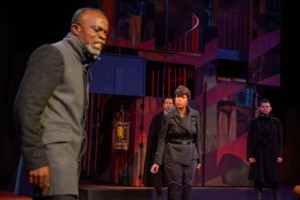
L. Peter Callender as Leontes, with Margo Hall as Paulina. Thee Tilghman and Christopher Michael Rivera in the background. Behind them is the two-story set. Photo by mellopix.com
A Winter’s Tale is not among the Shakespearean favorites, largely because its folklorish qualities can seem so culturally specific and archaic that it fails to remain relevant. CalShakes gets to the heart of folklore – keeping and cherishing cultural memory – by daring to remind us this is not just a story about some misty European heritage. It has enormous humanity, but only by seeing it in the unfamiliar guise of a tale told about all-too-recent history, (or maybe contemporary urban life), are we reminded from what pressures such grace emerges.
MUCH ADO is out on DVD today
October 8, 2013 § Leave a Comment
With the release of Jos Whedon’s MUCH ADO on DVD, I thought I might repost the link to my original review praising this enjoyable update. Off to get my very own copy!
Off to get my very own copy!
A quick roundup of the (classical) fall season in San Francisco
September 19, 2013 § Leave a Comment
What’s in store for classical theater fans this fall? While summer is traditionally the Shakespeare season, there is quite a bit that might interest an aficionado of the pre-modern theater coming soon to the San Francisco area:
Classical Theater Fall in SF
Macbeth, 9/21-22, San Francisco Shakespeare Festival at Jerry Garcia Auditorium, info
All’s Well that Ends Well, thru 9/28, Marin Shakespeare Company, info, my previous review
Comedy of Errors, thru 9/29 , Marin Shakespeare, info, my previous review
Imaginary Invalid, 9/5-29, Pacific Repertory in Carmel, info
Winter’s Tale, 9/25-10/20, California Shakespeare Festival in Orinda, info
Midsummer Night’s Dream, 10/3-20, Pacific Repertory in Carmel, info
Country Wife, 10/9-19, ACT’s MFA program fall repertory at the “Costume Shop.” info
Sueño (Life is a Dream), 10/9-19, ACT’s MFA program fall repertory at the “Costume Shop.” info
Macbeth, thru 10/16, We Players at Fort Point, info
Midsummer Night’s Dream, 10/18-27, UC Berkeley, info
Julius Caesar, San Francisco Shakespeare Festival’s extensive tour, many dates and locations, info
Antigone, 11/10, Cutting Ball Theater’s free Sunday Reading Series, info
Troilus and Cressida, 11/17-12/15, Impact Theatre, info
All’s Well that Ends Well, 12/5-15, Mendocino Theatre Company, info
Romeo and Juliet, 12/13-28, Ninjaz of Drama at the Phoenix, info to be posted here
Related Media:
 The Hollow Crown Series: Richard II, 9/20, Henry IV, Part 1, 9/29 Henry IV, Part 2, 10/4, Henry V, 10/11 PBS info
The Hollow Crown Series: Richard II, 9/20, Henry IV, Part 1, 9/29 Henry IV, Part 2, 10/4, Henry V, 10/11 PBS info
Othello, 10/12, 14, 29, National Theater at the Sundance Kabuki, production info, local ticket into
Macbeth, 11/4, 9 , National Theater at the Kabuki, production info, local ticket into
Coriolanus, 2/15, 17, National Theater at the Kabuki, production info, local ticket into
Mourning Shakespeare Santa Cruz
August 28, 2013 § 5 Comments
Woe, destruction, ruin, and decay;
The worst is death, and death will have his day.
Richard II, (III.ii)
Earlier this week, the University of California at Santa Cruz announced (through its Dean of the Arts David Yager) that it was pulling the plug on 32 year old, Shakespeare Santa Cruz, their professional theater company in residence. The current season will be its last. Although the finality and timing of the decision was apparently something of a surprise, SSC’s future has been cloudy for some time. The company has struggled since the economic collapse of 2008 decimated higher education funding in California, threatening everything beyond basic instruction.
I am not close enough to the situation to assess the necessity or justness of the decision, but I am certainly among those in mourning not only for death of the company but for the bigger idea it represented.
To me, that idea will always be defined by the late Daniel Seltzer’s 1975 report for the National Endowment for the Humanities about the relationship of professional theaters to American universities, The Ideal Theater-in-the-University. At the time it was written, Seltzer was the head of Princeton’s theater program, and a notable Shakespearean scholar in its English department. He had also just been nominated for a Tony Award for his performance in Jules Feiffer’s Knock, Knock. In other words, he was both a credentialed scholar and a successful actor in the competitive commercial theater. (Sometime those that can, also teach…)
I was lucky enough to meet Seltzer just as I was finishing my undergraduate work. I was a kid just off the farm in Idaho, and my public education (including exposure to Seltzer) was dramatically changing my life prospects. It was his compelling vision of the interaction of university life and theater that interested me then, and still inspires me all these years later. Seltzer participated not only in the commercial theater, but also in the growing regional theater movement – especially at the McCarter Theater – but he was convinced that the Theater-in-the-University (his term) was a special, and vitally important kind of theater, perhaps the most important of all.
In his report, his central argument was that a university theater does not exist just for entertainment, nor even for the specific education of aspiring theater artists. The theater, he believed, should be the campus gathering-place, where a living community converges to consider the important questions of the time. Advocating for his vision, he wrote, “We can take seriously the association of the arts – perhaps especially the performing arts – with important public questions, with the responsibilities of men in public trust, with matters relative to the nation’s well-being. A university is profoundly involved in both the past and the present, and a university’s theater can reveal how dynamically and excitingly the two are connected.”
Perhaps it all seems quaint and idealistic now, as most of our society has long since abandoned the idea that the performing arts are a living library, as indispensable to a complete education as the material library at the center of campus. The proposition that live theater is worth subsidizing for its civilizing value has been under steady attack for decades, not just in the university, but in society-at-large. In fact, it hardly seems fair to damn UC-Santa Cruz for giving up after 32 years on an idea that few other public universities ever took seriously. (There are less than a dozen theaters such as Seltzer imagined, and Audrey Stanley created at UCSC, in residence at public universities, and not much more than double that number if you include private ones. Perhaps the only remaining theater company directly comparable to Santa Cruz is the Utah Shakespearean Festival at Southern Utah University in Cedar City.)
Still, I cannot help but hope that in Yager’s promise to convene a blue ribbon committee to “reimagine how our campus could host a company that is financially stable, academically relevant, and closely aligned with the activities of a major research university,” there might be a chance for the continuation of the kind of idealism that powered Seltzer’s vision for cultural/academic interaction, if not for this specific incarnation of it. UC-Santa Cruz was, and is, an exemplary institution because it has fought the good fight on behalf of meritorious students who lacked the resources to buy life’s advantages at outrageously expensive private universities. Let us hope that throwing in the towel on Shakespeare Santa Cruz is not symbolic of a surrender to the forces that continue to divide our nation into the haves, and the have-nots. Our cultural heritage is too valuable to turn into another commodity.
Where words prevail not, violence prevails.
July 20, 2013 § Leave a Comment
Revenge tragedy is a bizarre genre, and these days (Hamlet excepted) it is rarely performed. Although the most popular and exciting genre of Elizabethan and Jacobean times it has now largely slipped from view.
The reason for this is that the genre is built on a view of the justice system as corrupt in favor of the wealthy and powerful. As in Hamlet, the revenger is driven to his desperate course because the government cannot, or will not, do its job. Claudius may be a murderer, but he is also the king and protected by his position as much as by his secret.
Other revenge tragedies of the period have mostly slipped out of the repertoire because their premise is far more firmly grounded in the corruption of justice, which fewer and fewer people feel about their democratic governments. Conventional wisdom says that they had become irrelevant.
I was thinking these thoughts as I sat waiting for a very rare modern performance of Thomas Kyd’s The Spanish Tragedy, one of the earliest and (in its time) most successful of all revenge tragedies, to begin. It was Saturday, July 13, 2013. I was making a final check of my smart phone before turning it off when I first heard that George Zimmerman had been found not guilty in the death of Trayvon Martin.
Watching that performance was very different than what I imagined might be coming. It suddenly had force and pertinence I was not expecting.
Halfway through I heard a line that (having read and taught the play) I should have known was coming, but I had forgotten came from this source: “Where words prevail not, violence prevails.”
I have been thinking a lot about it for many days, not least when I read that – apparently without irony – Zimmerman’s brother complained to the media that Zimmerman feared a vigilante would take justice into his own hands and seek revenge.
Violence becomes cyclical, revenge tragedies remind us, when we no longer trust that justice is blind. I fear that they are relevant again.
Why Verse?
June 17, 2013 § 1 Comment
Why does Shakespeare use verse so extensively in his plays? Why, in fact, do almost all playwrights before the twentieth century?
The conventional wisdom, which I think is wrong, is that verse is the best medium for aesthetically beautiful speaking and/or that it is easier to memorize. Both seem theatrically unlikely explanations to me.
Speaking “beautifully” was not widely admired, or even possible, until after the advent of dimmed indoor lighting in the nineteenth century, which hushed audiences for the first time. Before then, it was powerful voices that could make themselves heard over the crowd and command its attention that were admired. Verse does not help that.
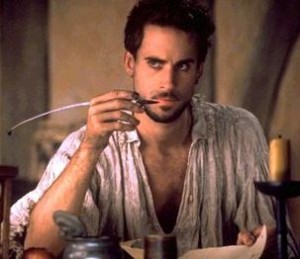 Joseph Fiennes in Shakespeare in Love
Joseph Fiennes in Shakespeare in Love
Verse is somewhat easier to memorize but not enough to justify the substantial effort it takes for the playwright to create it. Besides, the convenience of the actors has never been a noticeable consideration in the construction of plays.
Verse does accomplish something theatrically useful, but because we now live in a visual culture, it seems counter-intuitive. Verse is actually easier to hear and understand. In addition to content clues, we also get clues about what is being said from rhythm and (when it occurs) rhyme. In an oral/aural culture, greater communicative power is an advantage worth the trouble that versification requires.
Joss Whedon’s new film version of Much Ado About Nothing, which I reviewed at greater length in a previous post, got me thinking about this again. The performances in it are stripped of all conventions regarding “beautiful” Shakespeare, but there is a ferocious intensity around conveying the narrative. See it, or should I say listen to it, if you want to hear what verse is for.
